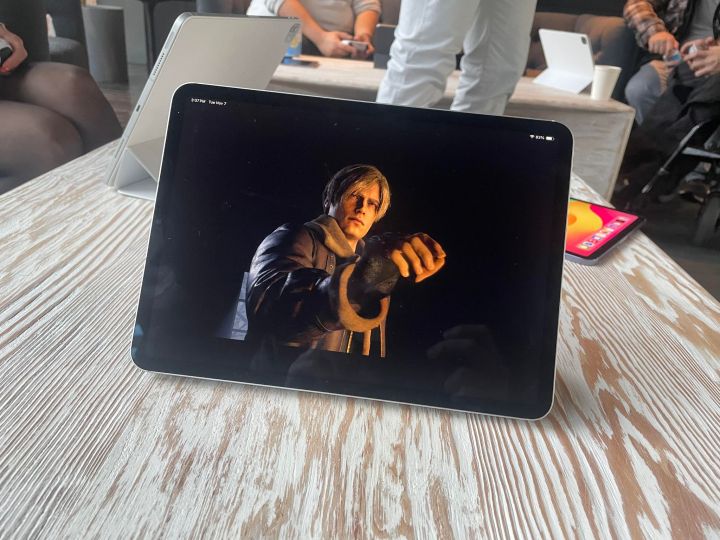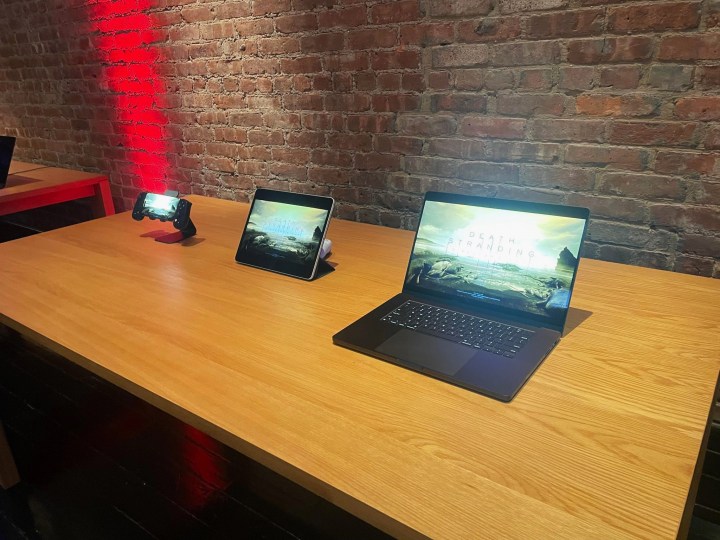Just two months ago, I had my mind blown when I saw Resident Evil Village running on an iPad. While I expected a very compromised experience, I was shocked when I saw how the horror game barely lost a step on the device. I pushed its settings to their limits and still came out with a fairly smooth experience capable of hitting high frame rates. Suddenly, the idea of playing a console quality game entirely on a mobile device didn’t seem like a far-fetched idea.
That was an impressive feat, but Resident Evil Village was built for the PS4 generation. The bigger test would come from more technically ambitious games that are either exclusive to new consoles or rebuilt with them in mind. I wouldn’t have to wait long to see that in action. At a recent Apple gaming showcase, I went hands-on with both Death Stranding: Director’s Cut and Resident Evil 4 running on a bevy of Apple devices, from the iPhone 15 Pro to a Mac Mini.
Sure enough, I still walked away as impressed as I did with Resident Evil Village. Both games run smoother than expected across devices without making too many sacrifices. What’s really starting to come into focus, though, is the potential benefit of gaming on a Mac ecosystem. Success just relies on Apple’s ability to snag games much more quickly rather than playing catch-up with old releases.
Gaming in the Apple ecosystem
I’d start my demo by firing up the first chapter of Resident Evil 4 on an iPad. That would be a make-or-break moment, as Apple faced the difficult task of proving that a game built for PS5 and Xbox Series X can run on a mobile device. Just as was the case when I demoed Village, Resident Evil 4 cleared that hurdle with ease. My session was remarkably smooth, as I was able to fire off quick headshots and parries just as efficiently as I had on PS5. While I didn’t have the option to tweak settings too much, I was able to max the frame rate up to 120 frames per second (fps) and get some strong performance from a small screen.

The iPad’s display does the horror game justice, too. It’s capable of producing some deep blacks that are crucial in Resident Evil 4’s moody opening segment, as Leon cuts through a dark house with his flashlight. I remain impressed by the level of detail these mobile Resident Evil ports are able to maintain. Even if they’re not technically as impressive as playing on a console, the smaller screen size of a device like the iPad means that any reduction in textures aren’t as noticeable as you’d expect when seeing screenshots out of context.
With that test successful, I’d move on to Death Stranding: Director’s Cut. While the original release was built for PS4, the Director’s Cut was specifically reworked for PS5. Considering its an enormous open-world game filled with detailed landscapes, it would be just as impressive a feat if Apple could get that game running on its devices. I’d first play the game on a Mac Mini M2, which had some mixed results. While the image quality was there, performance seemed a little choppy as it ran at a lower frame rate (though that issue was more pronounced due to the gigantic display I demoed it on).
I’d be significantly more impressed when playing a slice of it on an iPhone 15 Pro attached to a Backbone controller. Though I’d only play its first few minutes and watch an early cutscene, I’d see some incredible detail retained on the device. Terrain was as rich and earthy as ever and rain droplets especially looked remarkable. I could see the reduced frame rate in cutscenes, but that didn’t feel like that big of a loss on a phone screen.

As well as it ran, there’s a fair question one might ask: Why would you want to play a game like that on an iPhone? I’ve struggled to find that answer myself amid Apple’s recent gaming push, but a reasonable response finally came into focus during my demo. The real appeal here is cross-progression, as buying a game like Resident Evil 4 on one Apple device means you’d have access to it on all of them. Death Stranding is the perfect game to sell that aspirational vision, as it’s the kind of thing you can either sit down with for long sessions on a laptop or casually pick away at in a quick iPhone session. It’s a potentially powerful leveraging of Apple’s ecosystem that gives the company one leg up on gaming giants like PlayStation.
Of course, there’s still one big caveat that Apple needs to solve. It’s great that I can play Death Stranding on an iPhone, but am I really going to play it for the third time since its release four years ago? Apple is still playing catch-up with its games rather than landing new releases simultaneously as they launch on other platforms. That’s going to remain a sticking point until Apple can build stronger relationships with its partners.
A sea change may be coming, though. The Apple event I attended featured multiple recent releases running on MacBooks, including 2023 hits like Baldur’s Gate 3 and Lies of P. Even Resident Evil 4 will launch in the same year as its PC and console counterparts, dropping on December 20. The gap is closing with each wave of gaming releases, shrinking from a few years to a few months. The closer we get to “day one” releases, the better chance Apple has at selling the power of its ecosystem to skeptical gamers. It’s an uphill battle, but Apple at least seems serious about the climb.



